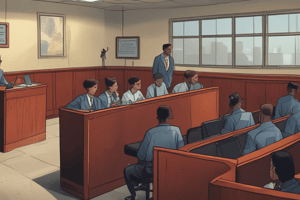Podcast
Questions and Answers
What are juvenile offenders?
What are juvenile offenders?
A broad category that encompasses youth engaged in a wide range of activities, from status offenses to serious violent offenses.
What did the Massachusetts stubborn child law address?
What did the Massachusetts stubborn child law address?
Incorrigibility and allowed parents to bring disobedient children before the court.
Juveniles' most common offenses are _____ crimes.
Juveniles' most common offenses are _____ crimes.
property
What is the pattern of juvenile violent crime?
What is the pattern of juvenile violent crime?
Which characteristics define the profile of delinquency? (Select all that apply)
Which characteristics define the profile of delinquency? (Select all that apply)
What is a delinquent?
What is a delinquent?
What defines a serious juvenile offender?
What defines a serious juvenile offender?
What characterizes a serious child delinquent?
What characterizes a serious child delinquent?
What is a chronic juvenile offender?
What is a chronic juvenile offender?
What is a violent juvenile offender?
What is a violent juvenile offender?
What are the two general onset trajectories of juvenile offending? (Select all that apply)
What are the two general onset trajectories of juvenile offending? (Select all that apply)
What does the Gun Control Act of 1968 state?
What does the Gun Control Act of 1968 state?
What are the predictors of youth violence?
What are the predictors of youth violence?
What does the Project on Human Development in Chicago neighborhoods study?
What does the Project on Human Development in Chicago neighborhoods study?
What is the purpose of Detention SHOCAP?
What is the purpose of Detention SHOCAP?
What is the intake SHOCAP process?
What is the intake SHOCAP process?
What is the role of prosecution SHOCAP?
What is the role of prosecution SHOCAP?
What does 'contagion' refer to in the context of violence?
What does 'contagion' refer to in the context of violence?
The juvenile justice perspective states that youths are victims of social forces.
The juvenile justice perspective states that youths are victims of social forces.
What is the public health perspective on youth violence?
What is the public health perspective on youth violence?
Flashcards
Juvenile Offenders
Juvenile Offenders
Youths involved in status offenses and serious crimes.
Massachusetts Stubborn Child Law
Massachusetts Stubborn Child Law
Allowed courts to address disobedient children in 1646.
Delinquent
Delinquent
Youth committing acts illegal for adults.
Serious Juvenile Offender
Serious Juvenile Offender
Signup and view all the flashcards
Serious Child Delinquent
Serious Child Delinquent
Signup and view all the flashcards
Chronic Juvenile Offender
Chronic Juvenile Offender
Signup and view all the flashcards
Violent Juvenile Offender
Violent Juvenile Offender
Signup and view all the flashcards
Early Onset
Early Onset
Signup and view all the flashcards
Adolescence-Limited
Adolescence-Limited
Signup and view all the flashcards
Gun Control Act of 1968
Gun Control Act of 1968
Signup and view all the flashcards
Contagion
Contagion
Signup and view all the flashcards
Juvenile Justice Perspective
Juvenile Justice Perspective
Signup and view all the flashcards
Public Health Perspective
Public Health Perspective
Signup and view all the flashcards
Detention SHOCAP
Detention SHOCAP
Signup and view all the flashcards
Intake SHOCAP
Intake SHOCAP
Signup and view all the flashcards
Prosecution SHOCAP
Prosecution SHOCAP
Signup and view all the flashcards
Common Juvenile Offenses
Common Juvenile Offenses
Signup and view all the flashcards
Traits of Delinquency
Traits of Delinquency
Signup and view all the flashcards
Juvenile Violent Crime Patterns
Juvenile Violent Crime Patterns
Signup and view all the flashcards
Influences on Youth Violence
Influences on Youth Violence
Signup and view all the flashcards
Study Notes
Juvenile Offenders
- Encompasses youths involved in status offenses (e.g., liquor laws, curfew violations) and serious crimes.
- Most common offenses among juveniles include property crimes: larceny, burglary, motor vehicle theft, vandalism, and arson.
Historical Context of Juvenile Law
- The Massachusetts Stubborn Child Law (1646) allowed courts to address disobedient children, marking early efforts in juvenile justice.
- Most states classify 17 as the upper age for status offenses; arrests for status offenses like truancy are declining.
Patterns of Behavior
- Juvenile violent crime peaks between 3 and 4 PM on school days, tapering off by 6 AM.
- Profiles of delinquency often reveal traits like impulsiveness, defiance, social assertiveness, and distrust of authority.
Definitions of Delinquent Categories
- Delinquent: Youth committing acts illegal for adults, aimed at avoiding the stigma of "criminal."
- Serious Juvenile Offender: Youth convicted of specific serious crimes (Part 1 offenses, excluding minor thefts).
- Serious Child Delinquent: Youth aged 7-12 involved in severe crimes like homicide or robbery.
- Chronic Juvenile Offender: Individual with five or more delinquency charges, irrespective of offense severity.
- Violent Juvenile Offender: Convicted of violent offenses against persons, particularly murder.
Offending Trajectories
- Two onset trajectories exist: early onset (persistently offending) and adolescence-limited (offending only during teenage years).
- Early violent offenders tend to commit more serious crimes and often continue violence into adulthood.
Legislative Context
- The Gun Control Act of 1968 prohibits federally licensed dealers from selling handguns to individuals under 21.
Influences on Youth Violence
- Predictors include prejudice, economic inequality, and cultural attitudes toward violence, influenced by early childhood experiences.
- Neighborhood conditions differ significantly by race and ethnicity, impacting youth behavior and risk of violence.
Interventions and Programs
- Detention SHOCAP: Policy for holding habitual offenders separately to protect staff and monitor activities.
- Intake SHOCAP: Involves mandatory holding of violent offenders and prompt legal notifications.
- Prosecution SHOCAP: Guidelines for prosecuting violent offenders, ensuring thorough representation in the judicial process.
Concepts in Juvenile Justice
- Contagion: Refers to the rapid spread of violence in high-risk areas or groups.
- Juvenile Justice Perspective: Views youth behavior as a result of free choice, warranting criminal punishment.
- Public Health Perspective: Considers youth victims of social conditions, advocating for treatment and addressing systemic needs.
Studying That Suits You
Use AI to generate personalized quizzes and flashcards to suit your learning preferences.




